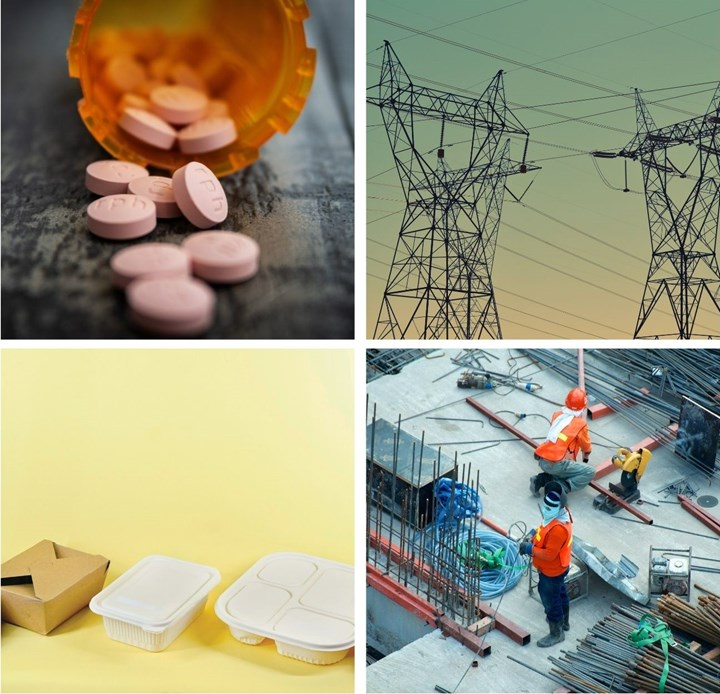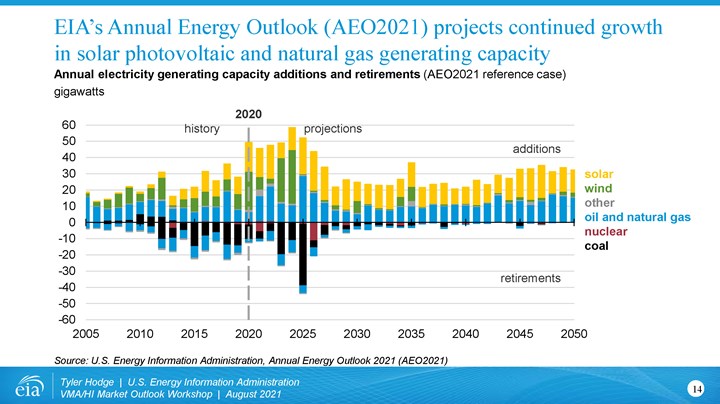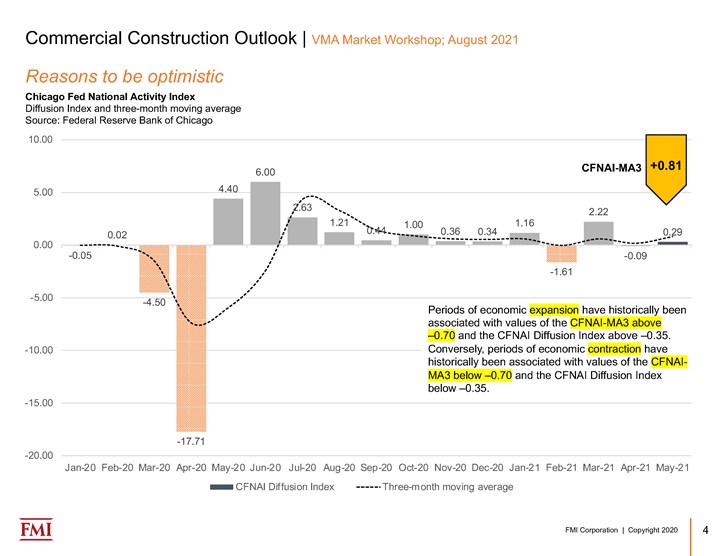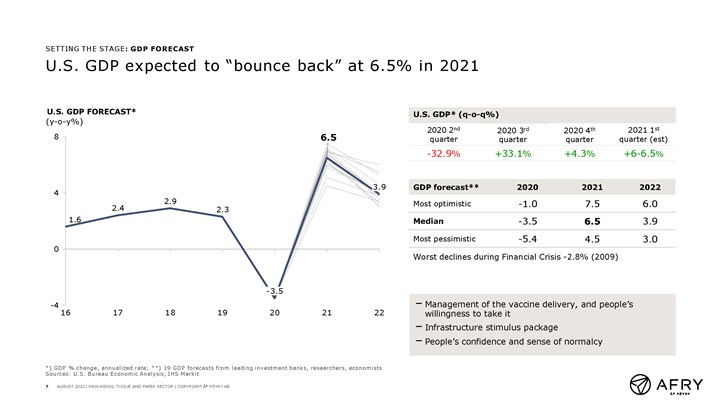Market Outlook 2022 Additional Industries Covered
VMA’s 2021 Market Outlook Workshop included these four remaining sectors: Pharmaceutical; Electricity; Packaging, Tissue and Paper; and Commercial Construction.

PHARMACEUTICAL TRENDS
The final session of the workshop is the third of the newcomers for this year: Doug Long, vice president of Industry Relations at IQVIA Institute. He kicked things off by delving right into COVID-19, its recent uptick of cases and deaths associated with the Delta variant and the parallel increase in numbers of people getting vaccinated after a peak in April of this year. As of early July (the most recent figures available to Long at the time of his presentation), almost half the country was vaccinated, with almost 80% of people age 65+ fully vaccinated.
Concerning prescription demand, 2020 had almost one billion fewer patient visits (diagnoses that require prescription medications) than the industry would normally expect, which is a 21% decline. As a result, there were large gaps in oncology, gastroenterology and dermatology. The utility of patients being able to use telehealth, something that existed pre-pandemic but was rarely used, skyrocketed in 2020. But even with increased telehealth visits, prescriptions are not readily written due to absence of labs, no face-to-face interaction and a general reluctance with new treatments. It is expected, Long said, that post-COVID dynamics will continue to have an impact with nearly 300 million diagnosis visits have not occurred in the first half of 2021.
Looking at diagnoses, other than migraine, most markets remain below average with a major lag in ADHD and depression prescriptions that are still at -18% and -21%, respectively, of what is expected.

And on the whole, Long explained, about 111 million fewer prescriptions have been written than is typical, a large portion of that figure can be traced to a lack of a cold-and-flu season in 2020/2021. Pediatricians are down almost 50% of prescriptions because children simply haven’t been sick because fewer were in school and for those going, hand washing and mask wearing has become the norm. Additionally, flu vaccine rates were up 40% for the 2020/2021 cold and flu season.
On the flip side, once the COVID-19 vaccination was available in spring of this year, traffic in retail pharmacies increased overall, but acute prescriptions have been down considerably, while most maintenance and refill prescriptions have trended above both 2019 and 2020 in 2021.
Regarding the public’s perception of pharmaceuticals and brand inflation, Long made a point to mention, “The tendency for the public to think that the reason for healthcare expenditures is growing the most is because of pharmaceutical products and that prices are raised willy-nilly.” Since the peak in 2015 that surpassed 12% brand inflation, the figure has dropped precipitously to the range of 4-5%. And where manufacturer net revenues have grown by $48 billion in the past five years, it’s a direct reflection on new products and utilization.
Long said another key factor in the market is something known as biosimilars. With some nuanced differences between generics and biosimilars, he illustrated the point, “Generics, which were 50% of the marketplace in 2000 and are now close to 86%, and biosimilars is the new hope we have, along with specialty generics, to bring products to the marketplace to help contain healthcare costs. The difference between a biosimilar and a generic is a biosimilar means it’s similar to the originator and the generic product means it’s exactly the same.” Long said the one to watch for is Humira, which is the biggest product in the United States and will face as many as six biosimilars competitors in 2023. Savings over the next five years resulting from biosimilars is projected to exceed $100 billion in the United States.
To finish up and in reflecting on the past 18 months, Long aptly summarized, “We’re trying to figure out when we’re going to get back to normal and will there ever again be a thing as the old normal or will it be new normal?” And in looking ahead five years, he said, “It’s a healthy market, it’s a growing market, it’s a market that has challenges, but it’s a market that has really stepped up during COVID.”
ELECTRICITY
Tyler Hodge, senior economist with the U.S. Energy Information Administration (EIA), reviewed the breakdown of electricity usage among a variety of manufacturing industries with chemicals and primary metals being the largest consumers of electricity in the United States, accounting for 23% and 14%, respectively. The manufacturing sector, he added, only generates about 15% of the electricity that they use, and the vast majority of what is used is purchased from power grids.
Last year, COVID-19 significantly affected the country’s use of electricity. Consumption in the industrial sector took a big hit as the economy slowed, as did commercial usage with retail businesses closing due to lockdown restrictions, but predictably, residential use soared during the pandemic with far more people working and shopping remotely and generally staying home instead of shopping at brick-and-mortar stores and eating in restaurants.
“On the supply side of things, there have been large shifts over the past 10 years in relation to generation capacity, with coal and petroleum-fired means having fallen about 29% in since 2011 and nuclear capacity has dropped about 4%,” said Hodge. Conversely, most of the growth has occurred in natural gas-generating capacity and also especially in renewables, specifically in solar and wind. Over the next two years, and likely longer term as well, these trends are expected to continue with wind and solar steadily continuing its upward trajectory but tapering to a slower rate overall.

“The interplay between coal and natural gas is really driven primarily by the price of natural gas,” Hodge explained, “and in 2020 with natural gas prices fell below coal for the first time and that’s why we saw a strong surge in the use of natural gas and a very large decline in the use of coal last year.” In looking ahead, however, the EIA is expecting a substantial increase for the price of natural gas, with prices not seen since 2014, spurring a subsequent temporary rebound for coal-generated electricity.
Finally, Hodge discussed the EIA’s Annual Energy Outlook that looks forward to 2050, natural gas and renewables are the primary capacity that’s going to be built through the next few decades. Regarding renewables, there is expected to be continued growth in solar photovoltaic combined with concentrated growth, but a lesser extent, wind and also corresponding increase of coal retirements that will be felt mostly through 2025.
COMMERCIAL CONSTRUCTION
This year, as we’ve come out of the initial effects resulting from COVID-19, Jay Bowman, partner at FMI Consulting drew comparisons to last year’s presentation when the pandemic was in full swing.
In terms of the various gauges used to measure the economy, Bowman described a different way to approach it that provides more information, especially timely data, versus what is gathered from standard sources. Sources he referred to as “overrated” included the Gross Domestic Product, Current Employment Statistics (CES), Consumer Confidence and Durable Goods Orders. These indicators, he said, are certainly important and valid, but there are elements the figures don’t convey and have limitations like frequency, revisions, double counting, sentimentality and volatility. By comparison, Bowman discussed the “underrated” category that tells a more complete and timely story: the Chicago Fed National Activity Index (CFNAI), Current Population Survey (CPS), retail sales and Purchasing Managers Index (PMI). These indicators tend to give a more holistic view and have strengths of being broad-based, non-sentiment-based, reflects the emerging gig economy and relies on hard data, frequency and stability.
“If we look at things truly from the construction side of things, the first thing we’d notice is the industry and the stakeholders in it are relatively bullish on the current expansion that we’re in,” Bowman said. He detailed two specific indicators, the Nonresidential Construction Index (NRCI) and CIRT Sentiment Index, and while both are more sentiment-based, they reveal some valuable trends. The NRCI measures growth of the economy excluding family homes in the form of a survey that FMI Consulting, Bowman’s company, distributes to contractors across the country every quarter. With the sentiment index reflecting either expansion (above 50) or contraction (below 40), last year at this time the United States was in a contraction at about 45, whereas in the second quarter of 2021, the number is 54.4, showing a relative confidence. And the CIRT index, relying more on hard data, reveals an optimism shown in its score of 83.9, which hasn’t been seen since 2016.

“The greatest risk we have to the current period we find ourselves in…is what’s going to happen around fiscal and monetary policy and how that translates to inflation,” said Bowman. And on that note, he believes the inflation we’re seeing now is not short-term and he suggested it will continue another two years. The almost $6 trillion of stimulus we’ve put into the economy in the past year has an impact that won’t unwind itself very quickly, which may slow the growth potential in the next couple years. Looking across broader industries, Bowman pointed to research conducted by Oxford Economics and McKinsey during the pandemic that shows how soon these respective industries anticipate being fully recovered in a less-constrained environment. Predictably, healthcare and social assistance was the first to recover, along with manufacturing and information services—while arts, entertainment and recreation, along with accommodation and food services, will lag until 2023 and beyond because they require large crowds and travel.
Across-the-board projected growth, Bowman illustrated, is expected to range from .5-10% in the next five years, with communication, manufacturing, multifamily and education ranking higher—and lodging, recreation, religious, public safety, offices, commercial occupying the lower side of the growth chart at 1.5-4%, respectively.
As a final reflection that addressed his third question posed at the outset of his presentation, Bowman touched on the juxtaposition of the permanent versus transitory change we’ve experienced through the pandemic and how technology has affected customers and, on the supply side, owners of these companies. He cited Walmart as an example, being the largest retailer in the United States, where it’s pivoting to meet customers’ needs for one-stop shopping and is specifically aiming to become the number one healthcare provider in the industry.
PACKAGING, TISSUE AND PAPER SECTOR
In line with all markets and a common thread that can be seen throughout all the workshop sessions, the pandemic has greatly impacted this industry in both positive and negative ways. This year has so far been one of growth and recovery for the most part, with some long-term changes and implications likely to result. Soile Kilpi, director at AFRY Management Consulting, illustrated trends showing 4% growth in 2021 for corrugated box/cardboard demand, spurred, as one would expect, largely by e-commerce growth, stimulus-driven spending and changing consumer habits. Holding steady was the folding cartons category with such factors as personal consumption spending nearing pre-pandemic levels, increased grocery spending and vaccinated consumers funneling money into these associated end-use markets. In the food service board sector, which includes plates and cups and takeout containers, it dropped off significantly in 2020 and it’s slowly recovering from that negative territory as we begin resuming travel, entertainment and events. On the downside for sectors, publication papers (move to digital means and a slow recovery for events, conferences and tradeshows for which collateral is produced and printed) are still in decline, as well as uncoated freesheet paper (employees working remotely and printing less) and market pulp.
Occupying a vast majority of the market, virgin and recycled containerboard capacity is more than 40 million tons, with about 70% of the market being mostly virgin-based and concentrated among the industry leaders such as International Paper, WestRock, PCA and Georgia-Pacific. Smaller producers like Pratt, Cascades and New Indy tend to lean more toward recyclables with 63% of market. New containerboard projects that will add 3.2 million tons of capacity are expected to come online by 2025 across the United States, centered largely in the Midwest and 90% of which will be producing recycled-based products.

Kilpi spoke about China’s aggressive building and plans to increase containerboard capacity despite its strengthened recovered paper (RCP) ban, so the question is where is the fiber coming from? There is currently a 15-million-ton fiber gap that would need to be bridged by increasing domestic RCP collection, increasing imports of virgin and recycled pulp, building new pulp capacity or invested in fiber assets overseas.
A new emerging market is molded fiber, Kilpi described, and although it is a small share of the overall packaging market, it has recently grown remarkably well as the need for plastic substitutions grows, so she said to look for more opportunities and continued growth.
Onto tissue, which of course had a banner year in 2020 with the pandemic and demand soaring due to consumers being home more and hoarding of supplies. This year, however, Kilpi said the demand has stabilized and the supply constraints seen at first have since eased up. And as people have increasingly ventured out and away from home in 2021, some input cost increases come into play, like higher market pulp prices, logistics and distribution costs.
Kilpi finished up discussing a new opportunity or product called interliner for containerboard boxes. It’s a new type of lightweight containerboard that’s made with thermo mechanical pulp and it’s an opportunity for newsprint producers who are experiencing declines. So far, a couple Nordic companies have launched the product and some North American suppliers are exploring a potential conversion. Plans are already in place for interliner being adopted in China, so that holds significant growth potential.
RELATED CONTENT
-
The Basics of Eccentric Plug Valves
Wastewater systems present many challenges to pumps and valves because the flow can contain grit, solids and debris, depending where in the process the equipment is located.
-
General Considerations for Control and Choke Valves Used in Offshore Oil and Gas Production
The application of control and choke valves used in offshore oil and gas production is a very broad field and in this article, some of the main considerations for valve selection will be addressed.
-
The Diverse Role Valves Play in the Chemical Industry
The chemical industry is extremely diverse with more than 60,000 known products. Like all process industries, the chemical industry needs valves designed for safe, efficient and reliable process operation.











 Unloading large gate valve.jpg;maxWidth=214)